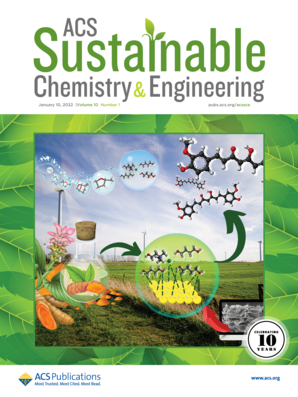Hierarchically Structured Ferric Oxides Derived from Fe-MOF-5-Wood for Scalable Cathodic H2O2 Electrochemical Synthesis
IF 7.1
1区 化学
Q1 CHEMISTRY, MULTIDISCIPLINARY
引用次数: 0
Abstract
Existing fossil-fuel-derived electrocatalysts still pose huge challenges in terms of cost-effective operation, safety, renewability, and ecological sustainability. Here, we demonstrate a simple effective strategy to construct a nanostructured wood-Fe-MOF-5 as a high-performance electrocatalyst for the air-cathodic electrosynthesis of scalable H2O2. Through coordinating of organic iron into regular MOF-5 in situ growing around the abundant oxygen-containing xylem cell walls vertically aligned within natural wood, we obtain a unique biconical hexagonal prism Fe-MOF-5 structure with a high specific surface area. The rapid gasification of Zn2+ pyrolytically dissociated from wood-Fe-MOF-5 modulates the catalytic electron structure of micro-mesoporous hollow ferric oxides (50–200 nm, hybrid Fe2O3/Fe3O4), enabling abundant carbon defects and oxygen vacancies offered by unsaturated coordinated Fe–O4. This catalyst achieves a highly selective 2e– oxygen reduction reaction (84.5%), boosting H2O2 production to 264.0 mg L–1 in the cathodic chamber using ambient air. Its production efficiency surpasses that of existing biochar-based electrocatalysts by up to 100 times. This strategy shows also universality to other lignocellulosic wastes such as bamboo and corn straw, manifesting also a huge potential in scalable H2O2 production.

从Fe-MOF-5-Wood衍生的层次结构氧化铁用于可扩展的阴极H2O2电化学合成
现有的化石燃料衍生电催化剂在成本效益、安全性、可再生性和生态可持续性方面仍然面临巨大挑战。在这里,我们展示了一种简单有效的策略来构建纳米结构木材- fe - mof -5作为空气阴极电合成可扩展H2O2的高性能电催化剂。通过有机铁在天然木材内垂直排列的丰富的含氧木质部细胞壁周围原位配位成规则的MOF-5,我们获得了独特的具有高比表面积的双锥六角形Fe-MOF-5结构。木材- fe - mof -5热解解离的Zn2+的快速气化调节了微介孔空心氧化铁(50-200 nm,杂化Fe2O3/Fe3O4)的催化电子结构,使不饱和配位的Fe-O4提供了丰富的碳缺陷和氧空位。该催化剂实现了高选择性的2e -氧还原反应(84.5%),在阴极室中使用环境空气将H2O2产量提高到264.0 mg L-1。其生产效率比现有的生物炭基电催化剂高出100倍。该策略也适用于其他木质纤维素废弃物,如竹子和玉米秸秆,在大规模生产H2O2方面也显示出巨大的潜力。
本文章由计算机程序翻译,如有差异,请以英文原文为准。
求助全文
约1分钟内获得全文
求助全文
来源期刊

ACS Sustainable Chemistry & Engineering
CHEMISTRY, MULTIDISCIPLINARY-ENGINEERING, CHEMICAL
CiteScore
13.80
自引率
4.80%
发文量
1470
审稿时长
1.7 months
期刊介绍:
ACS Sustainable Chemistry & Engineering is a prestigious weekly peer-reviewed scientific journal published by the American Chemical Society. Dedicated to advancing the principles of green chemistry and green engineering, it covers a wide array of research topics including green chemistry, green engineering, biomass, alternative energy, and life cycle assessment.
The journal welcomes submissions in various formats, including Letters, Articles, Features, and Perspectives (Reviews), that address the challenges of sustainability in the chemical enterprise and contribute to the advancement of sustainable practices. Join us in shaping the future of sustainable chemistry and engineering.
 求助内容:
求助内容: 应助结果提醒方式:
应助结果提醒方式:


